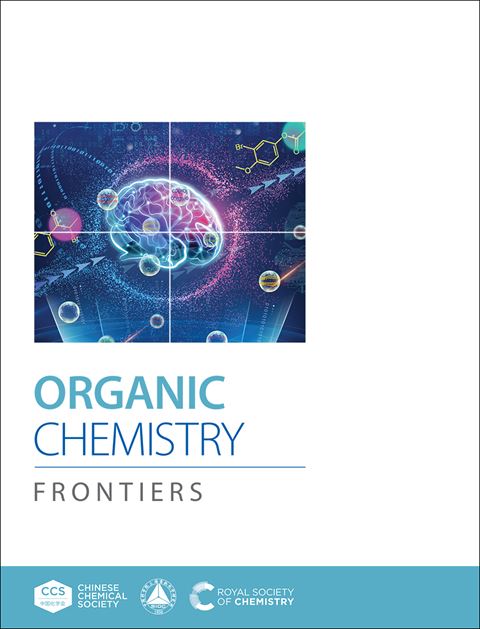Benzylic C–H bond functionalization through photo-mediated mesyloxy radical formation
IF 4.7
1区 化学
Q1 CHEMISTRY, ORGANIC
引用次数: 0
Abstract
Herein, we report a photo-mediated methodology for the benzylic C‒H bond oxygenation. Our approach employs in-situ generated (methylsulfonyloxy)-pyridinium mesylate salts to produce mesyloxy radicals apt for benzylic C‒H bond cleavage through hydrogen atom transfer (HAT). Subsequent oxidation of the benzylic radical yields a carbocation, functionalized by the mesylate counterion through oxidative radical-polar crossover (ORPC). The reactive benzylic mesylates are converted to stable benzylic alcohols via a straightforward protocol. Reaction optimization utilized modern design of experiment techniques (DoE) for facile setup and rapid reaction. Our proposed mechanistic paradigm is supported by comprehensive investigations, including fluorescence quenching studies, cyclic voltametric measurements, and determination of kinetic isotope effects (KIE). Density functional theory (DFT) calculations elucidate the divergent performance between (methylsulfonyloxy)-pyridinium salts and (trifluoromethylsulfonyloxy)-pyridinium salts. The functionalization of unactivated C–H bonds represents a versatile strategy for the diversification of drug intermediates in synthetic organic chemistry.1, 2 Besides transition metal catalysis, electrosynthesis or biocatalysis, the utilization of radical-species for C–H bond functionalization has been rapidly gaining attention.3-8 In the past, radicals were frequently generated under harsh reaction conditions, restricting compatibility with functional groups. However, the advent of photoredox catalysis has facilitated the generation of radicals under mild conditions.9,10 In this context, redox-active pyridinium salts have served as unique radical precursors, generating reactive species after single-electron reduction by an appropriate photoredox catalyst.11-15 Electronic effects have a significant impact on the generation and reactivity of radical species.16 For instance, the electronic properties of both the exocyclic and heteroarene substituents in redox-active pyridinium salts play a crucial role in dictating the formation of N-centered versus X-centered radicals through dissociative electron transfer (DET) (Figure 1).17 Strongly electron withdrawing N-substituents X (e.g. TfO‒ and F‒) favour heterolytic bond cleavage generating N-centered pyridinium radicals py•+ and less electron-withdrawing N-substituents (e.g. F3CO‒, RO‒) favour homolytic bond-cleavage generating an X-centered radical X•. It has been demonstrated that the resulting radicals can undergo a variety of chemical transformations, which were applied in both C(sp2)‒H and C(sp3)‒H bond functionalisations.18光介导甲氧基自由基形成的苯基碳氢键功能化
在此,我们报道了一种光介导的方法用于苯基C-H键氧化。我们的方法采用原位生成(甲基磺酰基)-甲磺酸吡啶盐,通过氢原子转移(HAT)产生易于裂解苯基C-H键的甲酰基自由基。随后,苯基氧化生成一个碳正离子,通过氧化自由基-极性交叉(ORPC)被甲磺酸反离子功能化。反应性甲酰基苯甲酸酯通过简单的程序转化为稳定的苯基醇。反应优化利用现代实验设计技术(DoE),便于设置和快速反应。我们提出的机制范例得到了全面研究的支持,包括荧光猝灭研究、循环伏安测量和动力学同位素效应(KIE)的测定。密度泛函理论(DFT)计算阐明了(甲基磺酰氧基)-吡啶盐和(三氟甲基磺酰氧基)-吡啶盐之间的不同性能。非活化C-H键的功能化代表了合成有机化学中药物中间体多样化的通用策略。1,2除了过渡金属催化、电合成或生物催化外,利用自由基进行C-H键功能化也迅速引起人们的关注。3-8过去,自由基在苛刻的反应条件下经常生成,限制了与官能团的相容性。然而,光氧化还原催化的出现促进了自由基在温和条件下的生成。9,10在这种情况下,氧化还原活性吡啶盐作为独特的自由基前体,在适当的光氧化还原催化剂的单电子还原后产生活性物质。电子效应对自由基的生成和反应性有重要影响例如,氧化还原活性吡啶盐中外环取代基和杂芳烃取代基的电子性质在通过解离电子转移(DET)决定n中心自由基和x中心自由基形成方面起着至关重要的作用(图1)17强吸电子的n取代基X(如TfO -和F -)有利于异裂键生成n中心的吡啶自由基py•+,而弱吸电子的n取代基(如F3CO -, RO -)有利于均裂键生成X中心的自由基X•。已经证明,所产生的自由基可以经历各种化学转化,这些化学转化适用于C(sp2) -H和C(sp3) -H键官能化
本文章由计算机程序翻译,如有差异,请以英文原文为准。
求助全文
约1分钟内获得全文
求助全文
来源期刊

Organic Chemistry Frontiers
CHEMISTRY, ORGANIC-
CiteScore
7.90
自引率
11.10%
发文量
686
审稿时长
1 months
期刊介绍:
Organic Chemistry Frontiers is an esteemed journal that publishes high-quality research across the field of organic chemistry. It places a significant emphasis on studies that contribute substantially to the field by introducing new or significantly improved protocols and methodologies. The journal covers a wide array of topics which include, but are not limited to, organic synthesis, the development of synthetic methodologies, catalysis, natural products, functional organic materials, supramolecular and macromolecular chemistry, as well as physical and computational organic chemistry.
 求助内容:
求助内容: 应助结果提醒方式:
应助结果提醒方式:


